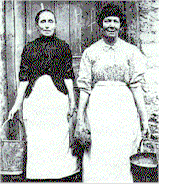| Back to Local History |
THE LIVES OF ORDINARY PEOPLE IN THE INNER-CITY years ago |
| Back to Local History |
My Grandfather, Jacob Poole, in his own words
by Sinead Watters We lived in a tenement house in Bridgefoot Street. We lived in one room with the rest of my family. The room consisted of two beds, a table and six chairs. There were five other families living in the same tenement house. I left school at fourteen so that I could get a job and help provide for the family. I worked as a chicken butcher in Byrnes off Thomas Street. I was also a barber, a motor mechanic, an electrician’s assistant. |
 I served in the army for over eight years
during World War 2 but because Ireland was neutral I did
not have to fight. I served in the army for over eight years
during World War 2 but because Ireland was neutral I did
not have to fight.One time we had to march to Cork and back - it took two weeks! I spent most of my time in the army boxing. I fought people from other command units and today I am part of the ex-boxer’s association.
|
THE TENEMENTS by Karen O’Callaghan By 1938, there were still 6,307 tenement buildings in inner-city Dublin. In these slums people lived in cramped conditions, huddled together in one room and one cold tap and one "pit" which served 100 persons.
|
 The women
took great pride in keeping their windows shining and
making their whites gleam! The women
took great pride in keeping their windows shining and
making their whites gleam! Each woman scrubbed her part of the hall or landing and stairs. However, children still suffered greatly from malnutrition and infectious diseases. |
MY GRANDMOTHER by Pamela Reid
She was the youngest in a family of 4. Her mother was a nurse and her father was a coach-smith. She went to boarding school in Dalkey and finished her education in Eccles Street. She left school at 16 to work in an office.
|
She remembers
that the living conditions in Dublin during those days
were very bad and that was when the houses in Crumlin,
Kimmage and West Cabra were built. During World War 2 everything was rationed you even had to use coupons to buy clothes. So she knitted a dress from fine twine and dyed it lavender. She was living on the North Strand when the bombs fell on 25th May and her husband, who was in the Irish Army was let home to check on his family. He found everyone safe! |